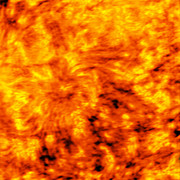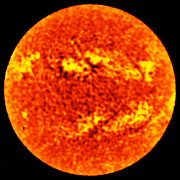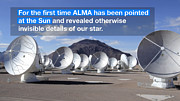Press Release
ALMA Starts Observing the Sun
17 January 2017
New images taken with the Atacama Large Millimeter/submillimeter Array (ALMA) in Chile have revealed otherwise invisible details of our Sun, including a new view of the dark, contorted centre of a sunspot that is nearly twice the diameter of the Earth. The images are the first ever made of the Sun with a facility where ESO is a partner. The results are an important expansion of the range of observations that can be used to probe the physics of our nearest star. The ALMA antennas had been carefully designed so they could image the Sun without being damaged by the intense heat of the focussed light.
Astronomers have harnessed ALMA's capabilities to image the millimetre-wavelength light emitted by the Sun’s chromosphere — the region that lies just above the photosphere, which forms the visible surface of the Sun. The solar campaign team, an international group of astronomers with members from Europe, North America and East Asia [1], produced the images as a demonstration of ALMA’s ability to study solar activity at longer wavelengths of light than are typically available to solar observatories on Earth.
Astronomers have studied the Sun and probed its dynamic surface and energetic atmosphere in many ways through the centuries. But, to achieve a fuller understanding, astronomers need to study it across the entire electromagnetic spectrum, including the millimetre and submillimetre portion that ALMA can observe.
Since the Sun is many billions of times brighter than the faint objects ALMA typically observes, the ALMA antennas were specially designed to allow them to image the Sun in exquisite detail using the technique of radio interferometry — and avoid damage from the intense heat of the focussed sunlight [2]. The result of this work is a series of images that demonstrate ALMA’s unique vision and ability to study our Sun.The data from the solar observing campaign are being released this week to the worldwide astronomical community for further study and analysis.
The team observed an enormous sunspot at wavelengths of 1.25 millimetres and 3 millimetres using two of ALMA's receiver bands. The images reveal differences in temperature between parts of the Sun's chromosphere [3]. Understanding the heating and dynamics of the chromosphere are key areas of research that will be addressed in the future using ALMA.
Sunspots are transient features that occur in regions where the Sun's magnetic field is extremely concentrated and powerful. They are lower in temperature than the surrounding regions, which is why they appear relatively dark.
The difference in appearance between the two images is due to the different wavelengths of emitted light being observed. Observations at shorter wavelengths are able to probe deeper into the Sun, meaning the 1.25 millimetre images show a layer of the chromosphere that is deeper, and therefore closer to the photosphere, than those made at a wavelength of 3 millimetres.
ALMA is the first facility where ESO is a partner that allows astronomers to study the nearest star, our own Sun. All other existing and past ESO facilities need to be protected from the intense solar radiation to avoid damage. The new ALMA capabilities will expand the ESO community to include solar astronomers.
Notes
[1] The ALMA Solar Campaign team includes: Shin'ichiro Asayama, East Asia ALMA Support Center, Tokyo, Japan; Miroslav Barta, Astronomical Institute of the Czech Academy of Sciences, Ondrejov, Czechia; Tim Bastian, National Radio Astronomy Observatory, USA; Roman Brajsa, Hvar Observatory, Faculty of Geodesy, University of Zagreb, Croatia; Bin Chen, New Jersey Institute of Technology, USA; Bart De Pontieu, LMSAL, USA; Gregory Fleishman, New Jersey Institute of Technology, USA; Dale Gary, New Jersey Institute of Technology, USA; Antonio Hales, Joint ALMA Observatory, Chile; Akihiko Hirota, Joint ALMA Observatory, Chile; Hugh Hudson, School of Physics and Astronomy, University of Glasgow, UK; Richard Hills, Cavendish Laboratory, Cambridge, UK; Kazumasa Iwai, National Institute of Information and Communications Technology, Japan; Sujin Kim, Korea Astronomy and Space Science Institute, Daejeon, Republic of Korea; Neil Philips, Joint ALMA Observatory, Chile; Tsuyoshi Sawada, Joint ALMA Observatory, Chile; Masumi Shimojo (interferometry lead), NAOJ, Tokyo, Japan; Giorgio Siringo, Joint ALMA Observatory, Chile; Ivica Skokic, Astronomical Institute of the Czech Academy of Sciences, Ondrejov, Czechia; Sven Wedemeyer, Institute of Theoretical Astrophysics, University of Oslo, Norway; Stephen White (single dish lead), AFRL, USA; Pavel Yagoubov, ESO, Garching, Germany and Yihua Yan, NAO, Chinese Academy of Sciences, Beijing, China.
[2] Indeed, this lesson has been learned the hard way: the Swedish–ESO Submillimetre Telescope (SEST) had a fire in its secondary mirror assembly after the telescope was accidentally pointed at the Sun.
[3] A map of the whole disc of the Sun was also made with a single ALMA antenna, using a technique called fast-scanning, at a wavelength of 1.25 millimetres. The accuracy and speed of observing with a single ALMA antenna makes it possible to produce a map of the entire solar disc in just a few minutes. These maps show the distribution of temperatures in the chromosphere over the whole disc at low spatial resolution and therefore complement the detailed interferometric images of individual regions of interest.
More information
The Atacama Large Millimeter/submillimeter Array (ALMA), an international astronomy facility, is a partnership of ESO, the U.S. National Science Foundation (NSF) and the National Institutes of Natural Sciences (NINS) of Japan in cooperation with the Republic of Chile. ALMA is funded by ESO on behalf of its Member States, by NSF in cooperation with the National Research Council of Canada (NRC) and the National Science Council of Taiwan (NSC) and by NINS in cooperation with the Academia Sinica (AS) in Taiwan and the Korea Astronomy and Space Science Institute (KASI).
ALMA construction and operations are led by ESO on behalf of its Member States; by the National Radio Astronomy Observatory (NRAO), managed by Associated Universities, Inc. (AUI), on behalf of North America; and by the National Astronomical Observatory of Japan (NAOJ) on behalf of East Asia. The Joint ALMA Observatory (JAO) provides the unified leadership and management of the construction, commissioning and operation of ALMA.
ESO is the foremost intergovernmental astronomy organisation in Europe and the world’s most productive ground-based astronomical observatory by far. It is supported by 16 countries: Austria, Belgium, Brazil, Czechia, Denmark, France, Finland, Germany, Italy, the Netherlands, Poland, Portugal, Spain, Sweden, Switzerland and the United Kingdom, along with the host state of Chile. ESO carries out an ambitious programme focused on the design, construction and operation of powerful ground-based observing facilities enabling astronomers to make important scientific discoveries. ESO also plays a leading role in promoting and organising cooperation in astronomical research. ESO operates three unique world-class observing sites in Chile: La Silla, Paranal and Chajnantor. At Paranal, ESO operates the Very Large Telescope, the world’s most advanced visible-light astronomical observatory and two survey telescopes. VISTA works in the infrared and is the world’s largest survey telescope and the VLT Survey Telescope is the largest telescope designed to exclusively survey the skies in visible light. ESO is a major partner in ALMA, the largest astronomical project in existence. And on Cerro Armazones, close to Paranal, ESO is building the 39-metre European Extremely Large Telescope, the E-ELT, which will become “the world’s biggest eye on the sky”.
Links
Contacts
Roman Brajsa
Hvar Observatory
University of Zagreb, Croatia
Tel: + 385 1 4639 318
Cell: + 385 99 2619 825
Email: romanb@geof.hr
Ivica Skokic
Astronomical Institute of the Czech Academy of Sciences
Ondrejov, Czech Republic
Tel: + 420 323 620 133
Cell: + 385 91 890 5815
Email: ivica.skokic@asu.cas.cz
Richard Hook
ESO Public Information Officer
Garching bei München, Germany
Tel: +49 89 3200 6655
Cell: +49 151 1537 3591
Email: rhook@eso.org
About the Release
| Release No.: | eso1703 |
| Name: | Sun, Sun spot |
| Type: | Solar System : Star : Feature : Photosphere : Sunspot |
| Facility: | Atacama Large Millimeter/submillimeter Array |









